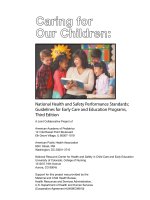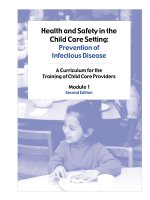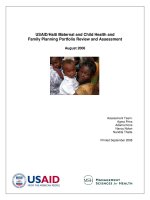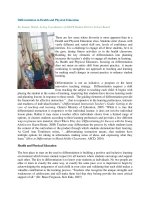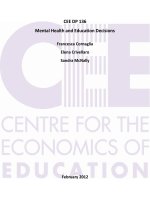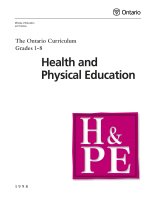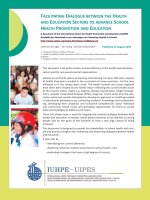HEALTH AND PHYSICAL EDUCATION: CONTENT KNOWLEDGE (0856/5856) pdf
Bạn đang xem bản rút gọn của tài liệu. Xem và tải ngay bản đầy đủ của tài liệu tại đây (313.26 KB, 10 trang )
Health and Physical Education: Content Knowledge (0856/5856)
Test at a Glance
Test Name Health and Physical Education: Content Knowledge
Test Code 0856 5856
Time 2 hours 2 hours
Number of Questions 120 multiple-choice questions 120 multiple-choice questions
Format Multiple choice Multiple choice
Test Delivery Paper delivered Computer delivered
Content Categories
Approximate Number of
Questions
Approximate
Percentage of
Examination
Health
I. Personal Health Care 19 16%
II. Family Living and Sex Education 16 14%
III. Community Health/Diseases
and Disorders 15 12%
Physical Education
IV. Fundamental Movements, Motor
Development, and Motor Learning 22 18%
V. Movement Forms 23 19%
VI. Fitness and Exercise Science 25 21%
About This Test
The Health and Physical Education test is designed for prospective teachers of health and physical education. Examinees
typically have completed a bachelor’s degree program in health and physical education, or have prepared themselves through
some alternative certification program. Approximately 50 of the 120 test questions focus on studies of health, and
approximately 70 focus on studies of and experiences in physical education.
This test may contain some questions that will not count toward your score.
Copyright © 2012 by Educational Testing Service. All rights reserved. ETS, the ETS logo, LISTENING. LEARNING. LEADING., PRAXIS I, PRAXIS II, and PRAXIS III
are registered trademarks of Educational Testing Service (ETS) in the United States and other countries. PRAXIS and THE PRAXIS SERIES are trademarks of ETS. 8601
1
VI
IV
V
I
II
III
Topics Covered
Representative descriptions of topics covered in each category are provided below.
Health
I. Personal Health Care
• Nutrition: dietary goals and guidelines, the food
pyramid, nutrients, metabolism, calories, fad diets,
and the relationship between diet and exercise
• Mental and emotional health:
self-concept/self-esteem, personality development,
defense mechanisms
• Consumer health: quackery, advertising, importance
of regular checkups, personal responsibility for
healthy behavior, and health “myths”
• Drug use and abuse: alcohol, tobacco,
over-the-counter drugs, prescription drugs, illegal
substances, “non-drug drugs” such as caffeine,
causes for the use and abuse of substances, alternate
coping skills, physical and psychological effects,
treatment and recovery
• Safety and injury prevention: general and specific
safety considerations for all movement activities;
fitness-related safety considerations, such as
warm-up/cool down, harmful exercise techniques,
and environmental conditions; health-related fitness
appraisals; personal goal-setting and assessment,
such as Physical Best, President’s Challenge, and
Fitnessgram; handling accidents and illnesses:
personal safety, the safety risks, first aid techniques
such as CPR and the Heimlich maneuver, water safety
certification; legal aspects of equipment and class
organization
• Methods, strategies, and resources for evaluating
students’ health behaviors and effecting appropriate
changes and meeting a pluralistic society’s needs for
health education relative to differing socioeconomic,
cultural, and ethnic backgrounds
II. Family Living and Sex Education
• Reproductive anatomy and physiology: growth and
development of the male and female reproductive
systems, family planning, pregnancy and childbirth
• Psychosocial development: family structure
relationships, peer relationships, values and
decision-making, understanding of bodily changes,
and personal growth and development
• Dating and marriage: readiness, responsibility,
communication, and assertiveness
• Parenting: responsibilities, child-rearing practices, and
communication
• Family and societal problems: conflict resolution,
domestic violence, rape, incest, teen pregnancy, and
divorce
• Gerontology: relation of lifestyle to health
maintenance, services for older citizens, dealing with
pain and infirmity
• Death and dying: acceptance, dealing with grief,
services and facilities for the ill, and planning for
death
III. Community Health/Diseases and Disorders
• Environmental issues: population, resources,
pollution, and urban-rural considerations
• Health agencies: public and private agencies, services
provided, cost considerations, and health care
delivery systems
• Health careers: types of occupational positions,
educational requirements prior to training, and formal
training required
• Communicable diseases: infectious diseases,
including sexually transmitted diseases (STDs)
• Chronic diseases: cardiovascular and neurological
diseases, cancer, diabetes, and other major illnesses
• Genetic: Tay-Sachs, sickle cell anemia, cystic fibrosis,
Down syndrome
• Mental and emotional illness: depression, anxiety
disorders, schizophrenia, and suicide
• Causes, prevention, control, treatment, and
counseling for communicable diseases; chronic
diseases; genetic disorders; and mental illness,
particularly related to teenage depression and suicide
Health and Physical Education: Content Knowledge (0856/5856)
Copyright © 2012 by Educational Testing Service. All rights reserved. ETS, the ETS logo, LISTENING. LEARNING. LEADING., PRAXIS I, PRAXIS II, and PRAXIS III
are registered trademarks of Educational Testing Service (ETS) in the United States and other countries. PRAXIS and THE PRAXIS SERIES are trademarks of ETS. 8601
2
Physical Education
IV. Fundamental Movements, Motor Development, and
Motor Learning
• Fundamental movements: locomotor, nonlocomotor,
manipulative, and falling/landing movement skills;
movement concepts such as body, space, effort, and
relationship
• Growth and motor development: role of perception in
motor development, such as in spatial movement
relationships; neurophysiology of motor control;
effects of maturation and experience on motor
patterns; biological and environmental influences on
gender differences in motor performances
• Motor learning: classical and current theories of motor
learning; variables that affect learning and
performance; effects of individual differences on
learning and performance
V. Movement Forms
• Dance and rhythmic activities: dance forms, such as
folk, square, and aerobic dancing; skill analysis of
dance movements
• Gymnastics: stunts and tumbling, use of gymnastic
apparatus, movement themes in educational
gymnastics
• Games: game forms, including invasion games;
cooperative and competitive games; analysis of skills,
rules, and strategies of particular games
• Individual/dual/team sports: analysis of skills, injury
prevention and safety, rules and strategies, facilities
and equipment, lifetime activities and recreational
pursuits, adventure and outdoor pursuits, and the
martial arts; emphasis is on basketball, soccer,
softball, tennis, track and field, and volleyball
VI. Fitness and Exercise Science
• Components: cardiorespiratory and muscular
endurance, body composition, flexibility
• Conditioning practices and principles: frequency,
intensity, time/duration, the role of exercise
• Human biology: anatomy and physiology, including
identification of major muscles, bones, and systems
of the human body and their functions; exercise
physiology, including terminology, components of
fitness, principles of exercise, roles of body systems
in exercise, short and long-term effects of physical
training, relationship between nutrition and fitness
• Biomechanics: terminology: mass, force, friction;
basic principles of movement: summation of forces,
center of gravity, force/speed relations, torque;
application of basic principles to sports skills;
methods of analyzing movement; analysis of basic
movement patterns: overhand throw, underhand
throw, kick
Health and Physical Education: Content Knowledge (0856/5856)
Copyright © 2012 by Educational Testing Service. All rights reserved. ETS, the ETS logo, LISTENING. LEARNING. LEADING., PRAXIS I, PRAXIS II, and PRAXIS III
are registered trademarks of Educational Testing Service (ETS) in the United States and other countries. PRAXIS and THE PRAXIS SERIES are trademarks of ETS. 8601
3
This test is available via paper delivery or computer delivery; other than the delivery method, there is no difference between
the tests. The test content is the same for both test codes.
To illustrate what the computer-delivered test looks like, the following sample question shows an actual screen used in a
computer-delivered test.
Here is the same sample question as it would appear on a paper-delivered test:
Which of the following is the capital of the
United States?
(A) New York, NY
(B) Washington, DC
(C) Chicago, IL
(D) Los Angeles, CA
For the purposes of this guide, sample questions are provided as they would appear in a paper-delivered test.
Health and Physical Education: Content Knowledge (0856/5856)
Copyright © 2012 by Educational Testing Service. All rights reserved. ETS, the ETS logo, LISTENING. LEARNING. LEADING., PRAXIS I, PRAXIS II, and PRAXIS III
are registered trademarks of Educational Testing Service (ETS) in the United States and other countries. PRAXIS and THE PRAXIS SERIES are trademarks of ETS. 8601
4
Sample Test Questions
The sample questions that follow illustrate the kinds of
questions in the test. They are not, however, representative
of the entire scope of the test in either content or difficulty.
Answers with explanations follow the questions.
Directions: Each of the questions or statements below is
followed by four suggested answers or completions. Select
the one that is best in each case.
1. Which of the following accurately describes the
correct sequence of procedures one should follow
when administering the ABC’s of cardiopulmonary
resuscitation (CPR)?
(A) Open airway, supply two full breaths, check pulse
(B) Check pulse, supply two full breaths, check
breathing
(C) Check pulse and breathing, open airway, supply
two quick breaths
(D) Supply two quick breaths, check pulse and
breathing, open airway
2. Which two of the following are the faults most commonly
exhibited by beginning swimmers who are learning the
breast stroke?
I. Failure to relax
II. Moving the arms too fast
III. Pulling the arms back too far
IV. Carrying the arms too high in the recovery
V. Improper timing between movements of the legs
and the arms
(A) I and IV
(B) II and IV
(C) II and III
(D) III and V
3. The exercise system known as “plyometrics” was
designed to meet which of the following objectives?
(A) Cardiovascular fitness
(B) Explosive power training
(C) Improved flexibility
(D) Muscular endurance
4. A negative energy balance of which of the following
would be required to lose one pound per week?
(A) 4,500 calories
(B) 3,500 calories
(C) 2,500 calories
(D) 1,500 calories
5. The speed of an object thrown overhand is most
affected by which of the following?
(A) Wrist flexion
(B) Hip rotation
(C) Grip-release
(D) Hand-head proximity
6. An increase in the risk of heart disease is associated
with an increase in all of the following EXCEPT
(A) blood pressure
(B) serum cholesterol
(C) low-density lipoprotein
(D) high-density lipoprotein
7. Which of the following activities is most aerobically
demanding in relation to kcal/hour burned?
(A) Bowling
(B) Volleyball
(C) Walking
(D) Cross-country skiing
8. In which of the following locomotor skills does each
foot have two tasks to complete before the weight is
transferred to the other foot?
(A) Galloping
(B) Running
(C) Walking
(D) Skipping
Health and Physical Education: Content Knowledge (0856/5856)
Copyright © 2012 by Educational Testing Service. All rights reserved. ETS, the ETS logo, LISTENING. LEARNING. LEADING., PRAXIS I, PRAXIS II, and PRAXIS III
are registered trademarks of Educational Testing Service (ETS) in the United States and other countries. PRAXIS and THE PRAXIS SERIES are trademarks of ETS. 8601
5
9. Which of the following is a problem most characteristic
of the primitive stage of forward rolling?
(A) Keeping the chin tucked
(B) Keeping the knees and hips flexed
(C) Losing the curl
(D) Using the hands to cushion the head contact
10. All of the following are characteristics of a correct mature
form for striking a ball with a racquet EXCEPT
(A) taking a forward step with the foot opposite to the
striking arm
(B) coiling and rotating the body forward as the racquet
is swung
(C) putting weight on the back foot and then shifting to
the front foot as the racquet is swung
(D) stopping the racquet at the point of contact with the
ball
11. When dribbling a soccer ball in a restricted space, the
player should attempt to do all of the following EXCEPT
(A) keep the ball close to the feet
(B) stay in a slightly crouched position
(C) use body feints and changes of speed
(D) use only the dominant foot for better control
12. It is reputed that Milo of Greece lifted a newborn bull
onto his shoulders each day until the bull became fully
mature. Milo followed what two principles of modern
muscle strength and endurance conditioning?
(A) Progression and overload
(B) Variable resistance and overload
(C) Frequency and progression
(D) Intensity and retention
13. In which of the following lists is each physiological factor
linearly (proportionately) related to oxygen
consumption?
(A) Cardiac output, diastolic blood pressure, heart rate
(B) Cardiac output, heart rate, work rate
(C) Core temperature, red blood cell count, work rate
(D) Minute ventilation, red blood cell count, respiration
rate
14. Angular motion is represented by which of the following?
I. The knees of a cyclist
II. The legs of a runner
III. The arms of a swimmer
(A) I only
(B) III only
(C) I and II only
(D) I, II, and III
15. The correct racing posture of a swimmer, a cyclist, or a
downhill skier minimizes the effect of
(A) lift
(B) propulsion
(C) drag
(D) gravity
16. Which of the following practice alternatives would best
promote motor learning and safety for potentially
dangerous sports such as pole vaulting and downhill
skiing?
(A) Whole
(B) Part
(C) Progressive-part
(D) Distributed
17. All of the following are immediate physiological benefits
of warm-down (cool-down) activities following vigorous
physical activity EXCEPT
(A) preventing blood from pooling in the legs
(B) increasing the rate of lactic acid removal from the
blood and skeletal muscle
(C) promoting the reduction of cholesterol in the blood
(D) reducing the risk of cardiac irregularities
18. Swimming one-half mile four times a week is most likely
to develop which of the following?
(A) Aerobic fitness
(B) Balance
(C) Flexibility
(D) Agility
Health and Physical Education: Content Knowledge (0856/5856)
Copyright © 2012 by Educational Testing Service. All rights reserved. ETS, the ETS logo, LISTENING. LEARNING. LEADING., PRAXIS I, PRAXIS II, and PRAXIS III
are registered trademarks of Educational Testing Service (ETS) in the United States and other countries. PRAXIS and THE PRAXIS SERIES are trademarks of ETS. 8601
6
19. Which of the following accurately represents the number
of extra calories a pregnant woman will need to
consume per day to prepare for a healthy birth?
(A) 200–300
(B) 1,000–1,200
(C) 1,500–2,000
(D) Double her normal caloric intake
20. Which of the following represents the correct sequence
of stages during normal vaginal childbirth?
(A) Expulsion, dilation, placental, contractions
(B) Dilation, expulsion, contractions, placental
(C) Contractions, dilation, expulsion, placental
(D) Placental, contractions, dilation, expulsion
21. Which of the following is the respiratory condition
characterized by inflammation, excessive mucus
production, and the constriction of the bronchi?
(A) Hay fever
(B) Emphysema
(C) Sleep apnea
(D) Asthma
22. Some people feel an improvement in their health after
taking a remedy that has no proven scientific effect on
health status. This is an example of which of the
following?
(A) A medical breakthrough
(B) A suppressant benefit
(C) Positive visualization
(D) Placebo effect
23. The hormone released by the hypothalymus of the brain
in males and females at the onset of sexual maturity is
(A) norepinephrine
(B) adreneline
(C) progesterone
(D) gonadotropin-releasing hormone (GnRH)
24. The primary means of managing diabetes is to keep
(A) cholesterol levels low
(B) sodium levels low
(C) blood sugar levels stable
(D) blood pressure stable
Health and Physical Education: Content Knowledge (0856/5856)
Copyright © 2012 by Educational Testing Service. All rights reserved. ETS, the ETS logo, LISTENING. LEARNING. LEADING., PRAXIS I, PRAXIS II, and PRAXIS III
are registered trademarks of Educational Testing Service (ETS) in the United States and other countries. PRAXIS and THE PRAXIS SERIES are trademarks of ETS. 8601
7
Answers
1. The correct answer is (A). The ABC’s of CPR, according to
the American Heart Association, are a series of steps. A stands
for airway, B for breathing, and C for circulation. The steps
necessary for an unconscious victim are as follows:
1. open airway with jaw thrust
2. if victim is not breathing, begin artificial breathing with
two quick breaths
3. check carotid pulse, and
4. if victim’s pulse is absent, begin artificial circulation.
2. The correct answer is (D). The swimmer’s arms should not be
drawn back beyond the shoulders, making III a common fault. The
pull, kick, glide sequence must also be executed in proper order,
making V the second most common fault.
3. The correct answer is (B). Exercise training drills termed
plyometrics, or explosive jump training, are used for football,
volleyball, sprinting, and basketball.
4. The correct answer is (B). A pound of body fat equals
3,500 calories. By reducing intake of food as in dieting or
burning more calories in exercise, a negative energy balance
is created. An individual wishing to lose one pound per week
would need to maintain a negative energy balance of 3,500
calories per week.
5. The correct answer is (B). The speed of a thrown object is
related to the amount of torque created by the rotation of the hips
added to the arm action. The body as a whole, therefore, throws
the object, hip rotation being a commonly observed attribute of
the mature overhand throw.
6. The correct answer is (D). High concentrations of low-density
lipoprotein (LDL), especially under high (blood) pressure and in the
presence of high serum cholesterol, are the major factors
associated with the artery-narrowing process known as
atherosclerosis. Whereas LDL carries cholesterol to the tissues of
the body, high-density lipoprotein (HDL) is thought to act as a
scavenger, gathering cholesterol from cells and returning it to the
liver to be processed to bile. A high HDL ratio to LDL in overall
serum cholesterol is a desirable trait.
7. The correct answer is (D). For a 150-pound person, bowling
would burn 140–280 kcal/hour; walking, 222–300 kcal/hour; and
cross-country skiing, 420–840 kcal/hour, making skiing the most
demanding of the choices on one’s aerobic capacity. Volleyball
involves less energy expenditure than either walking or
cross-country skiing.
8. In walking and running, each foot performs a single task
before the other foot takes over. In galloping, each foot performs
a single task, but one foot “walks” while the other foot “leaps.” In
skipping, each foot both “walks” and “hops” before the other foot
takes over. Therefore, (D) is the correct answer.
9. Choices (A), (B), and (D) are all characteristic of intermediate
or advanced levels of performing the forward roll. Choice (C) is
characteristic of early or primitive stages of performing the
forward roll and is the correct answer.
10. Choices (A), (B), and (C) are all generally accepted as
essential elements of mature striking form. “Following through”
with the swing is also an essential element, and thus (D) is the
correct answer.
11. Although most players, even at fairly advanced levels, will
have better control with the dominant foot than with the
nondominant foot, it is still essential that practice in dribbling at
every level emphasize use of both feet. (D) is the correct answer.
12. Choice (A) is the correct answer because progression and
overload are the terms used in discussions of fitness that refer to
adjusting the amount of exercise to a person’s present capacity
(overload) and gradually increasing the amount of exercise over
time to improve the level of fitness (progression).
13. Choice (B) is the correct answer because it is the only option
that does not include at least one item that does not increase in a
linear fashion as oxygen consumption increases.
14. The correct answer is (D). The definition of angular motion
clearly covers all three of the movements listed; when an object
acting as a rigid bar moves in an arc about an axis.
15. All three activities require that their participants maintain a
compact arrangement of the body so that it can move smoothly
through the medium (air or water) that is involved. (C) is the
correct answer, because the failure to observe this compact
bodily arrangement would hinder movement by creating drag.
16. Choice (C) describes a method of practice that involves
working on specific elements of a skill in isolation. Because this
method allows those elements of a skill that present the greatest
risk of injury to be mastered under controlled conditions before
the skill is attempted “whole” and under real conditions, (C) is the
correct answer.
17. This question is based on a standard textbook discussion of
the rationale for warm-down following vigorous physical activity,
which clearly establishes (A), (B), and (D) as real effects of proper
warm-down procedures. (C) is not such an effect and is thus the
correct answer.
Health and Physical Education: Content Knowledge (0856/5856)
8
Copyright © 2012 by Educational Testing Service. All rights reserved. ETS, the ETS logo, LISTENING. LEARNING. LEADING., PRAXIS I, PRAXIS II, and PRAXIS III
are registered trademarks of Educational Testing Service (ETS) in the United States and other countries. PRAXIS and THE PRAXIS SERIES are trademarks of ETS. 8601
18. The correct answer is (A). Swimming a distance such as
one-half mile would increase cardiovascular fitness just as
distance running would. Swimming may help maintain flexibility
but would not develop agility or balance.
19. The correct answer is (A). During the course of a pregnancy,
the fetus weighs anywhere from a few ounces to a few pounds.
The mother’s body needs only between 200 and 300 extra
calories per day during the pregnancy. That is about the amount
in one cooked chicken breast, without the skin.
20. The correct answer is (C). The end of the first trimester, called
transition, is the process during which the cervix becomes fully
dilated and the baby’s head begins to move into the vagina, or
birth canal. This transition period starts the chain of childbirth. The
second stage is the expulsion stage, during which the mother
gets ready to give birth to the child. The cervix is fully dilated and
the contractions become rhythmic, stronger, and more painful as
the uterus works to push the baby through the birth canal. After
the delivery of the baby, the mother continues into the third stage
of labor, during which the placenta is expelled from the womb.
21. The correct answer is (D). An asthma episode is a series of
events that result in narrowed airways. These include: swelling of
the lining, tightening of the muscle, and increased secretion of
mucus in the airway. Hay fever is an allergy caused by the pollens
of certain seasonal plants. Sleep apnea is a sleep disorder
involving pauses in breathing during sleep. Emphysema is a
pulmonary disease caused by exposure to toxic chemicals or
tobacco smoke.
22. The correct answer is (D). The placebo effect is created when,
in a controlled medical environment, a patient is given an inert pill
and not told that it is inert. The patient then describes the
improvement the inert pill is causing, thus showing that the
improvement was mental and not medical. This is also the case
in the uncontrolled environment as illustrated in the question.
23. The correct answer is (D). GnRH activity is very low during
childhood and is activated at puberty. During the reproductive
years, its release in higher quantities is critical for successful
reproductive function.
24. The correct answer is (C). Diabetes is a condition in which
blood sugar levels are high due to the body’s inability to process
the blood sugar correctly; therefore keeping blood sugar levels
stable would be the best way to manage diabetes.
Health and Physical Education: Content Knowledge (0856/5856)
94527-73059 • UNLWEBPDF812
9
Copyright © 2012 by Educational Testing Service. All rights reserved. ETS, the ETS logo, LISTENING. LEARNING. LEADING., PRAXIS I, PRAXIS II, and PRAXIS III
are registered trademarks of Educational Testing Service (ETS) in the United States and other countries. PRAXIS and THE PRAXIS SERIES are trademarks of ETS. 8601
X
